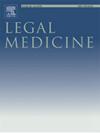Evaluation of two scoring systems assessing the epiphyseal union at shoulder joint as predictors of chronological age among a sample of Egyptians
IF 1.3
4区 医学
Q3 MEDICINE, LEGAL
引用次数: 0
Abstract
Age estimation has extensive medicolegal implications in civil and criminal identification. Despite the surge in adopting radiological investigations to assess developmental bony changes, the shoulder joint is understudied. A cross-sectional study was conducted, enrolling 283 shoulder radiographs of Egyptians, investigating the reliability of two previously established scores as predictors of chronological age using the epiphyseal maturation of proximal humerus and acromion process. Epiphyseal union of proximal humerus commenced at age of 16.1–17 and completed around 21, while complete acromial union was observed around the age of 20.8. Females significantly preceded males and showed lower mean total Scores A and B at different maturation stages. There was a significant strong positive correlation between the chronological age and the epiphyseal maturation of humerus, acromion and total shoulder scores with correlation coefficients between 0.84 and 0.9. The receiver operating characteristic curves showed significant discriminating power of the total shoulder Scores A and B as predictors of the ages of 14 and 16, with area under curves above 0.9, minimal accuracy of 96.5 % and p values of 0.001. Six proposed models were established where the model “age = 0.318 + (0.388) total shoulder Score A + (2.842) total shoulder Score B + 1.931 (sex)” showed the best significant prediction power of radiographic evaluation of epiphyseal maturation in the proximal humerus and acromion in estimating the ages between 8 and around 20 years (R2 of 0.812). Applying this model to assess the chronological age, especially if the results from the hand and teeth are inconclusive, is promising.
评估肩关节骨骺结合的两种评分系统作为埃及人样本中预测年龄的指标
年龄估计在民事和刑事鉴定中具有广泛的医学法律意义。尽管采用放射学检查来评估骨骼发育变化的趋势日益明显,但对肩关节的研究却不足。这项横断面研究收集了 283 张埃及人的肩部 X 光片,利用肱骨近端和肩峰突的骨骺成熟情况,对之前确定的两个预测年龄的分数的可靠性进行了调查。肱骨近端骺端结合始于 16.1-17 岁,完成于 21 岁左右,而肩峰完全结合则是在 20.8 岁左右。女性明显早于男性,且在不同成熟阶段的平均总分 A 和 B 都较低。计时年龄与肱骨、肩峰的骨骺成熟度和肩关节总分之间存在明显的正相关,相关系数在 0.84 和 0.9 之间。接受者操作特征曲线显示,肩关节总评分 A 和 B 对 14 岁和 16 岁的预测具有显著的鉴别力,曲线下面积大于 0.9,最小准确率为 96.5 %,P 值为 0.001。我们建立了六个拟议模型,其中 "年龄 = 0.318 + (0.388) 肩部总分 A + (2.842) 肩部总分 B + 1.931(性别)"模型显示,肱骨近端和肩峰骺端骨骺成熟度的影像学评估对估计 8 岁至 20 岁左右的年龄具有最佳的显著预测能力(R2 为 0.812)。应用该模型评估法定年龄,尤其是在手部和牙齿的评估结果不确定的情况下,是很有前景的。
本文章由计算机程序翻译,如有差异,请以英文原文为准。
求助全文
约1分钟内获得全文
求助全文
来源期刊

Legal Medicine
Nursing-Issues, Ethics and Legal Aspects
CiteScore
2.80
自引率
6.70%
发文量
119
审稿时长
7.9 weeks
期刊介绍:
Legal Medicine provides an international forum for the publication of original articles, reviews and correspondence on subjects that cover practical and theoretical areas of interest relating to the wide range of legal medicine.
Subjects covered include forensic pathology, toxicology, odontology, anthropology, criminalistics, immunochemistry, hemogenetics and forensic aspects of biological science with emphasis on DNA analysis and molecular biology. Submissions dealing with medicolegal problems such as malpractice, insurance, child abuse or ethics in medical practice are also acceptable.
 求助内容:
求助内容: 应助结果提醒方式:
应助结果提醒方式:


